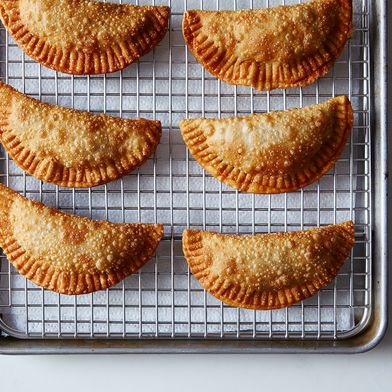I lived in Argentina for a little under a year, and I probably ate enough empanadas to average one a day. Ubiquitous, really good, addicting—all understatements to describe the palm-size pockets that house melted Roquefort cheese, crumbled beef, pulled chicken with chopped olives. They are, in many ways, a national identity manifested. Everyone you ask has a favorite: flavor, place to buy them, temperature at which to eat them, person to enjoy them with. In a daze of whatever you call homesickness for a place that isn’t your place of birth, I found myself scrolling through our site in search of an empanada recipe that could, in some way, bring me back to the country I once knew.
Empanadas in name exist across Latin America; empanadas in form—stuffed pockets of dough—exist across the world (dumplings, momo, ravioli, kninkali). In the midst of my search for the distinctly Argentine version, my eyes—or mouse, rather—landed on a recipe that seemed to fit the bill. It was named for a woman called Grandma Clari, and zeroed in on the precise combination of flavors in the strange but compelling stuffing mixture of the empanadas I had known. There were raisins and dustings of sweet paprika, cumin and bell pepper, all bound by beef, the cornerstone of the bovine-obsessed Argentine palate. The recipe came accompanied by a beautiful history, one drenched in nostalgia and aroma, memories of a time, a family member, and flavors difficult to forget.
I reached out to the community member who’d posted the recipe, Noga Tarnopolsky. She now lives and works in Israel as a foreign correspondent for the Los Angeles Times. We talked over the phone about food and national identity, the mind-numbing deliciousness of an empanada and, most of all, her Grandma Clari and the legacy she left behind. Below is a version of her story, edited and condensed for clarity.
My family is a very old Argentine family. My grandma Clari was born in Buenos Aires. She would have been 97 today. She and my grandfather bought a house in Entre Ríos, a rural province outside of Buenos Aires, on a big, big chunk of land. The kitchen in the picture on the site is in that house. That’s the place where I spent all of my winter breaks—I was lucky enough to go to college where I had two-month winter breaks, and I got to spend every one with all of my cousins in Argentina. That house is where I will always think about her the most. That’s the place where, if you’d ask for gnocchi, she’d say, anda a la huerta y tráeme papas (go to the garden and get me potatoes). She really was the queen of her realm there.
A post shared by Noga Tarnopolsky (@noga_ga) on Apr 1, 2018 at 10:23am PDT
She was of a generation of really brilliant women who didn’t have the professional opportunities that people have today, that women have today. I think she channeled a lot of that brilliance into her grandkids and into her food. She made linzer tortes out of quince jam along with what she used to call her strudel. She would throw it with her hands, like an Italian pizzaiolo, dough that became so thin you could see through it. She would make it the size of a whole table and she would spread on that butter and stewed apples and bread crumbs to make it crunchy. Then she would start wrapping all the layers of the butter dough around it and make a long snake of a thing, then cut it up. That was her apple strudel.
The country house was famous for the big asados, or barbecues. My grandmother used to slaughter her own sheep whenever one of her grandchildren had an important event. We would have these huge family get-togethers. Empanadas were always there. There’s a particular flavor to them that makes them so distinct. My grandmother used a lot of cumin and paprika. She was one of five sisters, and the habit among them was to have unbelievably lavish affairs with a table set, literally, to be photographed. She would make all of her own cakes: the strudel, little balls with dates and nuts, lemon squares that had meringue on top. It was endless.
A post shared by Noga Tarnopolsky (@noga_ga) on Dec 14, 2017 at 7:12am PST
Something like the empanada doesn’t exist in the States. It’s really the defining food for all of Argentina, and every province has its own version. But the empanada as a thing, as a crisp pocket of dough containing chopped beef is, I think, the definition of Argentina. I’ll give an example: In December I went back there, and friends of mine invited me to join them for a very fancy event at the home of the British ambassador. This was an event celebrating civil society organizations in Argentina, and the first thing to come out on trays were mini empanadas. You just cannot bring people together in Argentina without empanadas.
Dough for empanadas
-
8
cups flour -
2
teaspoons fine sea salt -
8 1/2
ounces flaky beef fat, rendered and cooled, or other fat or oil -
2 1/2
cups water
Filling for empanadas
-
1/3
cup raisins -
1/2
pound green olives, then some -
4
eggs -
1
pound excellent fillet of beef -
1
bunch spring onions, sliced -
1
medium-sized onion -
1
green pepper -
2
tablespoons rendered and cooled beef fat -
1
teaspoon coriander seeds -
1
dash salt and pepper, to taste -
1 1/2
teaspoons cumin -
1 1/2
teaspoons dried oregano -
1
tablespoon tomato paste -
1
teaspoon demerara sugar -
1
teaspoon sweet pimentón or paprika
Do you have a recipe that reminds you of a family member? Tell us about it in the comments.
(via Food52)

